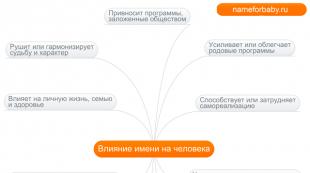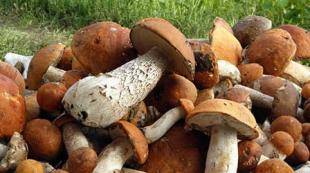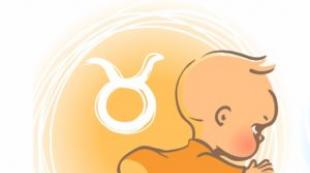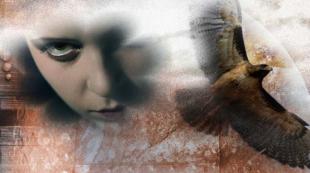Epics a source of knowledge about Kievan Rus presentation. Presentation of "epics of ancient Russia"
Bylina is a genre of oral folk art, which is an epic song-tale, which is read in a special recitative and tells about heroes and heroic episodes in the history of Russia in the 11th-16th centuries. A feature of this genre is that each epic is dedicated to one hero and a separate event or feat.
The word "epic" appeared in 1830, it was introduced by the scientist Ivan Sakharov. Prior to this, the songs-tales about the heroes and their exploits were called old. Researchers divide epics into two cycles: the more ancient Kyiv and Novgorod.
We read epics
- (another variant)
You will also find texts of epics in some articles about (see table).
Theme of epics
The theme of the Kyiv cycle can be called classical: epics describe individual exploits of various heroes to protect the Russian land from the Pechenegs, from various evil spirits in Kievan Rus. Most of these epics are dedicated to the reign of Grand Duke Vladimir. The main characters of the epics of the period of Kievan Rus are such heroes as Ilya Muromets, Dobrynya Nikitich, Alyosha Popovich.
In the later Novgorod cycle, the description of feats of arms recedes into the background and moves forward “Mr. Veliky Novgorod”, as this big city was often called, with its trade, inhabitants, and colorful descriptions of city life. Accordingly, the heroes of the epics are not warrior warriors protecting Russia from enemies, but merchants and dashing fellows. Examples of epics of the Novgorod cycle are Sadko's epics, epics about Stavra, about Vasily Buslaev, about Khoten Bludovich.
Sadko comes from a poor family, a guslyar. Thanks to the fabulous intervention of the sea king, he becomes a rich merchant and goes to trade overseas. On the way back, during a storm, he is given the opportunity to outwit the sea king and return to Novgorod with rich goods.
Stavr is a wealthy boyar and merchant, in general, a horse dealer and usurer, who is imprisoned at the behest of Prince Vladimir. Here, researchers find a poetically expressed echo of the real rivalry between Kyiv and Veliky Novgorod. And obviously, this is true, since the Novgorod narrator is clearly on the side of the boyar Stavr.
Also, the heroes of the Novgorod epics are simply daring fellows, the most striking example of which is Vasily Buslaev, the Novgorod hero, who is an ideal of valiant boundless prowess.
About the epic heroes of the Novgorod cycle, we can say that Sadko is the personification of the wealth of Novgorod, and Buslaev is his power.
Composition of epics
The composition of the plot of epics is always built according to one principle:
1. Beginning (plot plot)
2. The development of the action (a story about the events preceding the feat).
3. Culmination (description of the feat itself).
4. Decoupling (image of a crushed enemy, honoring the winner, etc.).
In some epics, the beginning is preceded by a "singing song", and the "outcome" follows the denouement. The purpose of the song is to grab the attention of the listener. Very often he draws majestic pictures of nature, setting the listeners on a solemn pathos and perception of something significant and important. For example, the singing of the epic "About the Nightingale Budimirovich":
Is it height, heavenly height,
Depth, depth, ocean-sea,
Wide expanse throughout the earth,
Deep waters of the Dnieper.
At the end of the epic, glory is most often given to the hero, for example:
“Yes, here we sing glory to Svyatogor and the hero”;
“Here Mikhail Potyk sing glory to his son Ivanov,
Silence to the blue sea
Obedience to all good people."
Some outcomes emphasize the historical authenticity of the epic:
Since then yes since then
They began to say Dobrynya in old times "
(the outcome of one of the variants of the epic "Dobrynya and Alyosha")
Compositional principles and techniques of epics
1. Principle of antithesis
The principle of opposition, which manifests itself primarily in the construction of the plot of epics. This is often seen already in the title: for example, "Ilya Muromets and Kalin Tsar", "Dobrynya and the Serpent". The epic heroes and their opponents are compared, who are contrasted primarily in their spiritual appearance, moral and moral qualities. The hero, as a rule, is kind, fair, honest, peaceful, noble and modest. Conversely, his opponent is angry, dishonorable, belligerent, self-confident and cunning. The principle of antithesis is also used when describing appearance: for example, Ilya Muromets is a man of ordinary height, and his opponent Idolische is of frightening size.
2. Selection technique
The technique of selection is often used already in the beginning in order to show who will be discussed in the epic. For example, the beginning of the epic "Fight of Alyosha with the Serpent":
Yes, the prince had, Prince Volodymyr,
I was going to it and a feast-bearer,
And honest, and laudatory, but joyful.
In a feast, princes, heroes would sit,
They are strong mighty heroes.
Yes, and there is no young Aleshenka at the feast,
Young Aleshenka is the light of Popovich.
In this beginning, you just see how the narrator, by means of emphasis, makes it clear that Alyosha will be the main character of the epic.
In many epics, we can come across a situation when Prince Vladimir addresses the heroes with some important matter, and they fall silent and hide behind each other. And only one and only one is called to carry out an important assignment. And this is not because everyone is cowardly and only one is brave. No, the technique of selecting one hero out of many simply works here, because. in the epic, everything is subordinated to the creation of the image of the hero. And the method of selection considered by us also serves this purpose.
3. Reception of hyperbolization
Hyperbolization (excessive exaggeration) is the most important principle of creating epics. They exaggerate the strength of not only heroes, but also their opponents. And the greater this strength of opponents, the more significant is the victory of the heroes over them, the more glorification they deserve. The same technique describes the strength of heroic horses, and many other points. For example, the wealth of Duke Stepanovich from Galich is described as follows:
“Vladimir, you are a prince and a stolen-Kyiv!
Three cartloads of papers came here,
And send here and thirty scribes,
It will not be possible to describe the estate in three years,
In those boundaries, you will not give a number.
(This is written by Dobrynya, who was sent to Galich to verify the words of Duke Stepanovich)
4. Dialogues
Dialogues play a significant role in the composition of the epic: they dramatize the plot and help to more fully characterize the characters, revealing their experiences and thoughts. Often the dialogue is the turning point of the epic. A very good example of the epic “Dobrynya Nikitich and Vasily Kazimirovich”: at the feast, “the daring good fellow” Vasily Kazimirovich receives the task from Prince Vladimir to take a huge tribute to Batur Batvesov. Saddened, Vasily leaves the feast: he does not like to carry tribute to the Busurman. He meets Dobrynya and a conversation will take place between them. Having learned about the order of Prince Dobrynya Nikitich, he says:
“We won’t take it from the prince from Vladimir,
We will not take tribute-duties from him, -
We will ask from the dog Batur Batvesov,
We will ask him for a tribute-duty "
With the help of this dialogue, the narrator unexpectedly changes the plot, the pathos of the epic increases, the attention and feeling of relief among the listeners grows: dear Dobrynushka did not let him down, he did not disgrace his honor and the Russian land. In such a simple but effective way, the feeling of national pride of one of the most beloved Russian heroes is revealed.
4. Reception of repetitions
An important compositional role in epics is played by the method of repetition of individual episodes, the speech of heroes, etc. Most often this repetition is three times, but it can also be twice. The main purpose of such repetitions is to most clearly express a thought that is especially important for the epic, to focus the listener's attention on some episodes that are very significant in terms of meaning, certain actions of the characters. Here's an example:
Seeing from the mountain an innumerable army of the enemy and realizing that one cannot cope with him, Ilya Muromets turns to the hero Samson Samoylovich with such an excited speech:
You are my godfather, father, Samson Samoylovich,
And you are the mighty Russian heroes,
You saddle-tko good horses,
And you sit down on good horses,
Go, yes, into the open field,
And under that under the glorious city of Kyiv city.
As under our something under the city near Kyiv
And the dog Kalin Tsar is standing,
And stands with the great troops,
He wants to destroy the capital city of Kyiv,
The black men is to cut everyone,
God's churches all down the smoke,
To Prince Vladimir and Queen Opraksa
He wants to cut down the riotous head.
You stand, for faith, for the fatherland,
You wait, for the glorious city of Kyiv city,
You wait, for the churches you are for God,
You take care of Prince Vladimir,
And with that queenly Opraksa!
(Hilferding, vol. 2, p. 25)
To this Samson Samoylovich replies:
Ay, goddaughter, you are my favorite,
I am old Cossack and Ilya Muromets!
And we won’t even saddle horses,
And we will not sit on good horses,
We will not go to the glorious open field,
May we not stand for faith, for the fatherland,
May we not stand for the capital city of Kyiv,
May we not stand for mothers of God's churches,
May we not take care of Prince Vladimir
Yes, even with Queen's Opraksa.
After all, he has a lot of boyar princes,
Feeds them and waters and favors,
We have nothing from the prince from Vladimir.
(Hilferding, 2, pp. 25-26)
Having heard the refusal of Samson Samoylovich, Ilya Muromets again appeals to him and other heroes with a call to stand up for Kyiv. Samson Samoilovich again refuses. Ilya Muromets addresses the Russian heroes for the third time. For the third time, Samson Samoylovich refuses. The appeal of Ilya Muromets and the answer to it in the epic are repeated three times verbatim.
What is the meaning and artistic necessity of such a repetition? The significance of this threefold repetition of the dialogue is enormous. Firstly, it expresses the main patriotic idea of the epic - the need to stand up for the Russian land; secondly, it expresses the social conflict between Prince Vladimir and the bogatyrs and, thirdly, through this technique, the main features of Ilya Muromets - his patriotism, will and perseverance - are emphasized, extraordinarily clearly expressed: at a time when mortal danger hung over the Motherland , he forgets a personal insult, speaks in defense of the Motherland, three times appeals to Russian heroes with an appeal to stand up for the defense of the fatherland.
Stylistic features of epics
Epics were created by tonic (it is also called epic, folk) verse. In works created by tonic verse, the verse lines may have a different number of syllables, but there should be a relatively equal number of stresses. In epic verse, the first stress, as a rule, falls on the third syllable from the beginning, and the last stress on the third syllable from the end of the verse.
The stylistic originality of epics is determined by the traditional expressive means of the genre. In epics, such literary devices as epithets, comparisons, and tautological phrases are most commonly used. Epithets in epics express this or that attitude of the people to the events depicted, that is, they have a certain estimated value. The main character of the epics is the "powerful hero". He is invariably called "good fellow", "daring fellow". He has a “great power”, “loud voice”, “heroic heart”. The faithful assistant of the hero is the horse, which in epics is endowed with bright epithets: “heroic”, “kind”, “frisky”, etc. Tautological epithets are also typical: bright room, salty salt, old age, honey honey.
To express opposition in epics, magnifying and diminutive forms are used: hands like rakes, eyes, heads with a tub, Ilyushenka, Dobrynyushka, Aleshenka, Ovdotyushka.
Which became famous during the reign of Prince Vladimir. We also learned from epics about how the heroes fought for Russian fortresses, how they invited peasant heroes to the princely squad.
Epics glorified the military exploits of Russian heroes in the fight against the Polovtsians and Pechenegs. Once the prince of the Pechenegs offered to meet on the battlefield two heroes - Pecheneg and Russian. Vladimir agreed. The hero of the Pechenegs entered the battlefield. He was so huge and scary that none of Vladimir's warriors dared to go to a duel with him.
Then one citizen turned to the prince, who said that he had a younger son, Nikita Kozhemyak. The townsman said that once Nikita got angry and tore the calfskin he was holding in his hands. He was so strong. Vladimir decided to test Nikita and launched an angry bull at him. Nikita grabbed the bull by the horns and knocked him down. Vladimir understood that Nikita had great power.
But Nikita was short. When he went out to fight the giant Pecheneg, the Pecheneg warriors laughed. They did not believe that Nikita could win this battle. But the Russian hero grabbed the Pecheneg, picked him up and threw him to the ground. Vladimir was so delighted with the unprecedented strength of Nikita that he took him to his squad. Kozhemyaka became a noble man from a simple tanner.
The epics contain many stories about the cunning and intelligence of the Russian people, who sometimes defeated the Pechenegs by deceit. They forced them to return to the steppe without a fight.
In epics they also praised women who, not by force, but by cunning, defeated enemies,
as Vasilisa Mukulishna, daughter of Mikula Selyaninovich. She saved her husband Stavr Godinovich by dressing upinmen's dress, Tatar and presentingshis ambassador from Golden Horde.
The epics tell about princely feasts, about the wealth of the princely court, about the boyars and warriors of the prince, about how they collected tribute from neighboring peoples. Prince Vladimir himself for his glorious state affairs in epics was called Vladimir the Red Sun Work based on the painting by V.M. Vasnetsov "Three heroes"
In order to better understand who the epics are talking about, we will consider Vasnetsov's painting “Three Heroes”, because it best of all reveals to us the glory of Russian heroes.
Dobrynya Nikitich, Alyosha Popovich and Ilya Muromets gaze into the distance, tirelessly guarding the borders of the Russian land. The heroes are strong and majestic, their horses are strong. Which of the heroes is depicted in the center ? (In the center of the picture, the oldest hero is Ilya Muromets. ) The wind tousled his gray hair. He carefully looks from under his hand, if there is a enemy somewhere. He is in chain mail, in his hand a spear, a hero is ready for battle.Ilya Muromets -favorite hero of Russian epics. His exploits cannot be erased in the memory of the people - after all, he protected people from a fierce enemy. This is the personification of the indestructible strength of the heroic squad, the mighty guardian of Kyiv from "filthy horde" that raided Orthodox Russia. He serves the Motherland with honor and glory. One Ilya Muromets always remains the "hope" of the affectionate Prince Vladimir. Ilya Muromets, a peasant son, is rich in bold truth-womb. Sometimes the princes do not like the truth of the peasant, gray, "unwashed." Ilya Muromets gets into the cellars for her, behind the iron gates. But this does not detract from his love of truth, he does not put up with "falsehood-flattery." That is why Russia remembers him.
The epics say that “in the city of Murom, and in the village of Karacharov” Ilya Muromets was born in a simple peasant family. Father's name was Ivan. Born sick and frail. His legs were so weak that he could not walk. So Ilya's parents put it on the stove. So he lay there for thirty years and three years. Ilya had already become an adult, his beard had grown, but he could not do anything because of his illness. Neither plow the field, nor graze cattle, nor go hunting.
Once a magician came to the hut of Ilya Muromets - an old man in white clothes and with a long white beard. I saw Ilya and began to shame him for his laziness and idleness. And then he predicted to him that he would become a great warrior-hero, defender of his native land. Ilya was surprised: “How can I perform feats if I have lain on the stove all my life?” And the magician answered him: “And you get up, try, maybe it will work out!”. Ilya got down from the stove, put his feet on the floor and felt a powerful force in himself. He looked around, but the magician was not there.
As if in a dance, hands to hips,
Leaning left, right
Turns out to fame!
Watching the video for the song "Our Heroic Strength"
To view a presentation with pictures, design, and slides, download its file and open it in PowerPoint on your computer.
Text content of presentation slides: Material Material sources are objects that people have preserved or found as a result of archaeological excavations. These include: tools, jewelry, utensils, treasures (coins), clothes, huts (estates) ... Written sources Written sources include: chronicles of life ... contracts of writing letters sources These are songs, fairy tales, epics. Epics are the historical memory of the people about the times of Kievan Rus - the Old Russian state. Oral sources Epics - a source of knowledge about Kievan Rus In ancient times, the storytellers of epics did not tell, but sang them, playing along on the harp. The gusli is a plucked folk instrument And strong, mighty heroes in glorious Russia! Do not ride enemies on our Earth! Do not trample their horses on the Russian Land! Do not overshadow our red sun! Bogatyrs are the main characters of epics. Viktor Mikhailovich Vasnetsov. "Bogatyrs". Ilya Muromets Alyosha Popovich The most famous among the heroes was Ilya Muromets - calm, courageous, severe, the strongest of the heroes, a symbol of peasant wisdom. Dobrynya Nikitich is the personification of politeness and graceful nobility. Alyosha Popovich is a symbol of cunning, crafty and dreamy. Epic hero - incarnation best qualities people: service to the motherland, courage, justice, self-esteem. Epics told about the wanderings of heroes in search of exploits ... ... about battles with enemies ... "Volga and Mikula Selyaninovich" The plowman plows, urges, hums at his filly. He lays furrows like deep ditches, twists oaks out of the ground, throws boulders aside. Only the plowman's curls sway, crumble like silk over his shoulders. And the plowman's filly is not wise, and his plow is maple, silk tugs. Volga sent ten knights. They turn the bipod in twenty hands, but they cannot budge. Then Volga went with the whole retinue. Thirty people, without a single one, stuck around the bipod from all sides, strained, went knee-deep into the ground, but did not move the bipod even by a hair. Here the plowman himself got down from the filly, took hold of the bipod with one hand, pulled it out of the ground, “Svyatogor the Bogatyr” shook the earth out of the plows. The holy mountains are high in Russia, their gorges are deep, the abyss is terrible. There, the wolf will not run, the eagle will not fly, only Svyatogor the hero rides between the cliffs on his mighty horse. The horse jumps over the abyss, crosses from mountain to mountain. Svyatogor is taller than the dark forest, props up the clouds with his head, gallops over the mountains - the mountains stagger under him. Once Svyatogor rides along the valley between the cliffs, and suddenly - a living person is walking ahead. An unprepossessing little man is walking, trampling with his bast shoes, carrying a purse on his shoulder. Svyatogor was delighted: if he had someone to say a word to, he began to catch up with the peasant. He is in a hurry, the horse gallops with all his might from Svyatogorov, but he cannot catch up with the peasant .. Svyatogor shouted to him: Hey, a passer-by, well done, wait for me! Svyatogor wanted to pry his purse with a whip, but the purse did not move, he began to push with a spear - it would not move. Svyatogor dismounted from his horse, grabbed the purse with both hands, jerked with all his strength - only raised it to his knees. Look - and he himself went knee-deep into the ground, not sweat, but blood flows down his face, his heart sank. Sadko In the glorious Novegrad How was Sadko the merchant, a rich guest. And before Sadko had no property: Some were guselki yarovchaty; Sadko went and played at the feasts. Sadko was not invited to an honorable feast. Sadko missed that. Sadko, from Novgorod! How Sadko began to play in the guselki yarovchaty, How the king of the sea began to dance in the blue sea, How the king of the sea danced - In the blue sea, the water stirred, With yellow sand, the water became confused, Many ships began to break on the blue sea, Many righteous people began to drown. He pulled it out, broke the pegs in the yarovchaty. The king of the sea said to him: Oh, you’re Sadko Novogorodsky! Why don’t you play guselki yarovchaty? - My strings in the guselki pulled out, And the pegs in the yarovchaty broke off. He got up Sadko early in the morning, Look: there are three hundred red girls I missed the first three hundred girls, And I missed the other three hundred girls, And I missed the third three hundred girls. As Sadko went to bed on the first night, Sadko woke up in Novy-gorod, On the Chernava River on a steep ridge. . Collectors of epics Kirsha Danilov His collection, containing 26 epics, has been reprinted 8 times since 1804. Rybnikov Pavel Nikolaevich In 1861-67 4 volumes (165 epics) "Songs collected by Rybnikov" were published. Alexander Fedorovich Hilferding"Onega epics", recorded by A.F. Hilferding" was reprinted 4 times. Books about heroes Cartoons about heroes Fairy tale Bylina Similarities: 1. Both fairy tales and epics have existed since ancient times. 2. Both genres at that time were works of oral folk art. Differences: 1. The tale is based on fiction. 2. Tales were "told". 1. The epic is based on real events, with elements of fiction.2. Epics "said" - they sang or spoke, accompanied by a harp. Epic true story It was in fact - a story about the history of the Russian land, about the exploits of folk heroes. fairy tale Folk heroes have fantastic power, deal with monsters. + What kind of knowledge about Kievan Rus do epics carry? about the life of combatants, their weapons, service with the prince; about merchants, their ships and goods, entertainment and trade: about the service of heroes on the outskirts of Kievan Rus, etc. And not a fairy tale, and not a true story. , C=L Bylina B#1 =D, Dobrynya? O C=C Muromets, Sadko GOSSVABYARYTYOGTRO Svyatogor-bogatyr Write separately first the red and then the purple letters. Make words out of them and you'll get a name epic hero. Kievan R u ss Write down the blue and red letters separately from the largest to the smallest. What state name did you get? Kievan Rus. Prepare an expressive reading of the epic "Nikita Kozhemyak". Read the text in the textbook. Answer the questions of the textbook.
Attached files
1. Prove, using the example of specific epics, that they are sources of knowledge about Kievan Rus.
2. Explain what an epic is and how it differs from a fairy tale; with the help of an epic to show life in Kievan Rus.
3. To develop the ability to cite information from the text of the epic as evidence; connected and detailed presentation of facts based on sources (epics).
4. To cultivate respect for working people, to explain the importance of developing industriousness, to involve students in self-assessment of their knowledge.
Download:
Preview:
Subject: Epics - a source of knowledge about Kievan Rus.
Goals:
- Prove on the example of specific epics that they are sources of knowledge about Kievan Rus.
- Explain what an epic is and how it differs from a fairy tale; with the help of an epic to show life in Kievan Rus.
- To develop the ability to cite information from the text of the epic as evidence; connected and detailed presentation of facts based on sources (epics).
- Cultivate respect for working people, explain the importance of developing industriousness, involve students in self-assessment of their knowledge.
Basic knowledge.
Epics are a source of knowledge about Kievan Rus. Basic terms and concepts: Epics, brother.
Equipment and materials:
Epics "Sadko", "Volga and Mikula Selyaninovich", Vasnetsov's painting "Three Heroes".
Lesson type: Combined.
- Organizing time.
We are studying the big topic "Kievan Rus". We will find out when the first Slavic principality of Rus was formed, how they defended their lands and strengthened their borders, learned a lot about the Rurik dynasty (first princes).
1. Auction of names.
Restore correct order reign of the first Russian princes.
2. Oleg IX century IX - Rurik
4. Olga 912 finished 912 - Oleg
3. Igor 972 died 945 - Igor
1. Rurik 945 died 950 - Olga
6. Vladimir 950 Ser.X 972 - Svyatoslav
5. Svyatoslav 988 baptized. 988 - Vladimir
1. - Which of the princes united the Slavic tribes?
(Varangian Prince Rurik united Eastern Slavs in the first Slavic principality - Rus. The principality began to be called the Russian land. The city of Novgorod became the capital, main city in Russia.
2. - Which of the princes fulfilled his main task, united the Novgorod and Kyiv lands? (Oleg seized Kyiv by cunning, united the Novgorod and Kyiv lands. The city of Kyiv became the center of Russia "Mother of Russian cities." 879
3. Guess who owns the words: "I want to avenge my husband." How Princess Olga avenged her husband (p. 144).
4. Which of the princes sent the message "I'm coming at you" to the enemy. (The son of Igor and Olga, Svyatoslav was strong, courageous. He always won victories in battles. When the prince went into battle, he sent the message “I’m coming at you” to the enemies.
5. From what skulls did the Pecheneg Khan order to make a cup for wine, bound in gold? Underline the correct answer: Igor, Svyatoslav, Oleg. Svyatoslav with his retinue was returning on boats along the Dnieper River from Byzantium. They are tired, from battles and battles. Pechenegs attacked, Svyatoslav and combatants perished. According to legend, the prince of the Pechenegs ordered to make a cup for wine from the skull of Svyatoslav. She was bound with gold and at feasts he drank from it as a sign of victory over Russian soldiers).
6. Which of the princes was popularly nicknamed the "Red Sun"? Name the tasks that were the main ones for the prince:
- Protect Russia from enemy attacks.
- To streamline the collection of tribute - polyudie.
- He managed to organize the defense of the country and unite all Russian lands under his rule.
- Russia was fortified: they built cities - fortresses, established the protection of the country's borders. But it was difficult to manage such a country.
1) - Who helped Vladimir cope with this task. (Squad).Individual task.
Historical dictation.
Insert missing letters.
The main member in Ancient Russia was k...v. He had under his command
na - these are armed people who forced anyone to obey the prince. The prince consulted with the retinue, went to war, divided the booty.
2) individual task.
- What peoples did Russia fight in the 10th century, defending their lands?
Hungarians, Khazars, Pechenegs, Cumans, Vikings, Mongols.
- Homework repetition
Teacher: - Vl did a lot. The red sun for Russia, but contradictions arose, there was no complete unity among the Russian people. Prince Vladimir understood and wanted to unite all the inhabitants of Russia.
- with the help of what?
Historical alphabet: Pechenegs, captivity, polyudie, prisoners, giving, Polovtsy, campaign, predictions, Perun.
Who is Perun?
The religion of our ancestors is paganism.
The task of Prince Vladimir.
Unite all with the help of the faith of one God and under the rule of one prince.
- Who are Christians?
Questions session. Selective reading.
- Where did Christianity come from?
- What ceremony was required to become a Christian?
- When was Christianity adopted and how did baptism take place in Russia? 988 Raboba
- Why was acceptance important? Read out.
- Who is Jesus Christ, what other commandments do you know?
- After the adoption of Christianity, the Russian Church was formed.
- Who ruled the Russian Church. (Scheme parsing)
How Christianity spread in Russia, uniting all the inhabitants of the country.
Vocabulary: Preachers, Christians,
Baptism, priests, cross, prayer, Patriarch, charity
Show a set of postcards. - choose a church, a monastery.
- Who are monks?
- How did the Kiev-Pechersk Monastery arise?
- Can monk Anthony be called a saint.
- Explanation of the new topic.
More than 1000 years ago, there was no written language in Russia, and in order to preserve the memories of any outstanding person or event, people composed a Story about him - an epic.
Lesson topic message:
"Epics - a source of knowledge about Kievan Rus"
Vocabulary: epics
- A story is an event that took place in life, i.e. in fact.
- A story that is based on fiction, fantasy, is
- What epics do you know?
- Conversation on the painting "Three heroes"
a) Name the heroes.
b) What did the heroes do?
- Work with additional material Bogatyr Ilya Muromets.
a) Why was Ilya Muromets revered?
- The teacher's story with selective reading.
a) How the life of Ilya Muromets has changed.
b) What does it mean to be...
c) Why was the horse a faithful companion and fighting friend of the hero?
Conversation:
- The story of Svyatogor and Mikul Silyaninovich.
- The story of Nikita Kozhemyak.
- Epics glorified the military exploits of Russian heroes in the fight against the Polovtsians and Pechenegs.
Let's summarize the conversation:
What else do epics tell about? Read out.

Volga - a werewolf hero
In Russian folklore, the bogatyr Volga, who is also a prince, the leader of the squad, the elder of the family, is one of the most ancient characters. Volga did not differ in special strength, his main "weapon" is the ability to turn into any living creature. He is a werewolf wizard who inherited his magical properties from his serpent father.
Volga is a werewolf hero. Hood. G.N.Yudin

Volga with a squad
Volga gathered a squad, trained soldiers, and he made his first military campaign in the kingdom of the Turkish Sultan. Volga's squad captured rich booty - a lot of gold, silver, precious stones. But Volga did not stay in Turkey, but returned to his homeland, began to reign and collect taxes from his peasants.
Volga with a squad. Hood. G.N.Yudin

Volga and Mikula Selyaninovich
Mikula Selyaninovich - a simple peasant, a plowman who plowed the land so that you could hear it for three miles, uprooted rhizomes, threw out huge boulders. Volga realized that Mikula had heroic strength, and invited him to join his squad. Mikula agreed, but first he decided to test the strength of the Volga warriors by asking them to pull a plow out of the ground, shake it off and throw a bush behind the willows so that evil people would not covet his good. Volga's warriors could not do this. Only Mikula pulled the plow out of the ground with one hand, shook it off and threw a bush behind the willows. So a simple peasant, a plowman Mikula Selyaninovich, shamed the heroes of Volga Svyatoslavovich. This epic is called “Volga and Mikula Selyaninovich”.
Mikula Selyaninovich and Volga. Hood. G.N.Yudin

Svyatogor
The Russian hero Svyatogor lives in the holy mountains, rarely descends from them to people. It is huge, “higher than a standing forest, rests its head under a walking cloud”, it is hardly worn by mother earth. He embodies a mighty, gigantic power, but he is a lone hero and his power is useless. Svyatogor did not accomplish any feats, he only boasted in vain of his prowess, for which he suffered. He was unable to lift the bag from the ground. And the plowman Mikula Selyaninovich easily threw her on his shoulder and went on his way.
The Russian bogatyr Svyatogor pulls a bag. Hood. I.V. Simakov
Svyatogor. Hood. N.K. Roerich

Ilya Muromets
The image of Ilya Muromets, the most famous and beloved Russian hero among the people, embodies the best national traits: kindness, strength, justice, honesty. The people's memory has preserved more than ten epic stories about his exploits. Ilya Muromets is a collective image of the defender of the Russian land.
Bogatyr. Hood. V.M.Vasnetsov
Monument to Ilya Muromets in Murom

Healing of Ilya Muromets
According to epics, the peasant son Ilya was born in the village of Karacharovo near Murom. From birth, he could not move and lived like this until 30 years old, lying on the stove. He was healed by the elders, Kaliki passersby, endowed him with great strength, they said that he would live and live, fight a lot and he had nowhere to wait for death. Ilya Muromets picked up a horse, Burushko-kosmatushko, and went to military service.
Disease of Ilya Muromets. Hood. P.M. Kubeeva

Ilya Muromets and the Nightingale the Robber
Ilya Muromets accomplished his first heroic deed during a trip to the capital city of Kyiv. Near Chernigov, he met with the enemy "black force", preparing to capture the city. He beat her all and drove into Chernigov-grad. Chernigov met him with joy, offered him to reign with them. Elijah refused. He needs to go to Kyiv. The peasants warned him that it was dangerous to drive along a straight road, in the forest on seven oaks sits the Nightingale the Robber, Odikhmantev's son, a terrible creature that frightens everyone with its terrible nightingale whistle, snake hiss, animal growl, from which people die. Nobody managed to defeat him.
You can read about who defeated the Nightingale the Robber in the epic "Ilya Muromets and the Nightingale the Robber".
Ilya Muromets strikes the Nightingale the Robber. Hood. N.N. Karazin

Ilya Muromets and Poor Idolishche
This epic has come down to our time in several versions. One says that the action takes place in Kyiv, the other - in the capital of Byzantium, Constantinople. The filthy idol is a generalized image of a foreign enemy, an invader. They could be a Tatar Khan or a Pecheneg. Ilya Muromets went to Tsargrad to free the city from the terrible Idolish that had captured it.
The victory over this foreign enemy is mentioned in the epic "Ilya Muromets and the filthy Idolishche".
Bad idol. Hood. P.M. Kubeeva

Ilya Muromets and Kalin Tsar
In this epic, the struggle of the Russian people against the Mongol-Tatar invasion is reflected in a generalized form. The image of Kalin Tsar embodies the features of the leaders of the Tatars, Mamai and Batu.
Once Ilya Muromets had a strong quarrel with Prince Vladimir the Red Sun. The prince ordered to punish the hero - to put him in a deep cellar, not to give him anything to eat or drink. His wife Apraksia found out about the cruel decision of her husband and realized that a big trouble could happen if enemies attacked Russia, Kyiv could not resist, its inhabitants were full.
You can read about how the Russian hero defended his native land in the epic “Ilya Muromets and Kalin-Tsar”.
Ilya Muromets and Kalin Tsar. Hood. G.N. Yudin

Death of Svyatogor
The epic hero Svyatogor was the strongest, the greatest among all Russian heroes. But in his long life he did not accomplish any worthy feats. Just before his death, Svyatogor wanted to give Ilya Muromets his strength and his horse. However, Ilya refused. He does not need excessive strength, from which the mother of the earth cheese suffers, and someone else's miracle horse is not needed either.
Ilya Muromets and Svyatogor. Hood. AND I. Bilibin

Nikitich
Dobrynya Nikitich possessed considerable strength, achieved victories in military affairs thanks to his dexterity and intelligence. He accurately shot from a bow, deftly fought with sabers, but he also skillfully played the harp. He was a versatile person, aroused the interest of many people. In the epic, Dobrynya bathes in the Puchay River - this is a symbol of baptism and kills the Serpent - destroys the symbol of paganism.
Campaign of Dobrynya Nikitich against the Fierce Serpent. Hood. G.N. Yudin

Nikitich and Serpent Gorynych
The seven-headed Serpent Gorynych lives on the Sorochinskaya mountain, breathes fire, grabs people with trunks, strangles them. Many Russians are held captive by the Serpent. Dobrynya Nikitich was warned by his mother Amfela Timofeevna not to go to this mountain, not to tempt fate. He did not listen to her. On Mount Sorochinskaya, he trampled all the snakes and released all the captured Russians. Above the fire-breathing river appeared the Serpent Gorynych with twelve trunks. Dobrynya was not at a loss, threw a hat with sand right into the eyes of the Serpent. The Serpent Gorynych went blind, flapped his wings, howled in pain and fell to the ground. Dobrynya wanted to cut off the fire-breathing head of the Serpent with a knife, but he begged for mercy. Dobrynya believed him, took pity and let him go, but, as it turned out, in vain.
Fight Dobrynya with the Serpent. Hood. V.M. Vasnetsov

Dobrynya Nikitich and Fun Putyatichna
Zabava Putyatichna is the niece of the Kyiv prince Vladimir. She was kidnapped by the Serpent Gorynych after he was spared by Dobrynya Nikitich. Prince Vladimir was very sad, he asked Dobrynya to release his beautiful niece. The bogatyr again rode up Mount Sorochinskaya, trampled on the serpents, and began to release the captured Russians from captivity. The Serpent Gorynych got angry and challenged Dobrynya to a fight. For three days and three nights they fought, exhausted, neither one defeated the other. Then Dobrynya gathered his last strength, but the Serpent could not stand it, stumbled. Here the hero cut off his head, and then released Zabava Putyatichna from the snake mountain. Everyone thanked Dobrynya Nikitich and promised to keep a great memory of him.
The battle with the Serpent and the liberation of Zabava Putyatichna is mentioned in the epic "Dobrynya and the Serpent".
Dobrynya frees Zabava Putyatichna. Hood. I.Ya.Bilibin

bride for Dobrynya Nikitich
Epics about the marriage of Dobrynya Nikitich are found in different options. One tells of Dobrynya's chance meeting in an open field with one horseman, whom he at first mistook for a hero. It took him a lot of effort to get closer and realize that he was wrong. For a hero, he took the girl, the beautiful Nastasya, the daughter of Mikulishna, strong, ready to give a worthy rebuff to any man. Dobrynya liked Nastasya very much, and the hero wooed her. She agreed to become his wife.

Nikitich and Khan Botian
The epic about two heroes, Dobrynya Nikitich and Vasily Kazimirovich, tells about that time in the history of Russia when the Russian princes had to pay tribute to the Golden Horde. But Dobrynya did not want to pay. Together with Vasily Kazimirovich, he managed to defeat the Tatar Khan Botian with intelligence and strength. Russian heroes not only did not pay tribute to the khan, but, on the contrary, forced him to pay tribute to them. And they brought a lot of wealth to Kyiv.
Dobrynya is the ambassador of Prince Vladimir. Hood. G.N. Yudin
Dobrynya and the Tatar heroic fighter. Hood. G.N. Yudin

Alesha Popovich
Bogatyrs (Dobrynya Nikitich, Ilya Muromets, Alyosha Popovich). Hood. V.M. Vasnetsov
The third most important Russian hero, Alyosha Popovich, was not as strong as his two older brothers - Ilya Muromets and Dobrynya Nikitich. But he was brave to the point of recklessness. He defeated enemies in Russia not so much by force as by courage and cunning.

Alyosha Popovich and Tugarin Zmeevich
Tugarin Zmeevich. Hood. P.M.Kubeeva
Once Alyosha Popovich challenged Tugarin Zmeevich, who captured Kyiv and ruled it. His servants carried him on a golden stretcher, he did not bow to anyone, did not greet anyone. Alyosha Popovich killed the villainous infidel, and as proof he brought the head of his enemy to Prince Vladimir. The epic "Alyosha Popovich and Tugarin Zmeevich" tells about their battle.

Stavr Godinovich
Stavr Godinovich is a young Novgorod boyar, famous for his playing the harp. The epic about Stavr Godinovich is based on a historical fact: in 1118, the Kyiv prince Vladimir Monomakh imprisoned the boyar Stavr Godinovich in a dungeon for some faults. In the epic, the action is moved more than a hundred years ago, to the era of the reign of another prince, Vladimir the Red Sun, the baptist of Russia. His wife freed her beloved husband by cunning.
Stavr Godinovich in the dungeon. Hood. P.M. Kubeeva

A woman is a hero
Vasilisa Mikulishna Hood. S.S. Solomko
Vasilisa Mikulishna is the wife of the boyar Stavr Godinovich, who was imprisoned in a dungeon. She is a raspberry - a woman-hero. She was not only beautiful and strong, but also smart. Vasilisa Mikulishna freed her husband from the dungeon by cunning. The epic "The Cunning of the Woodpile" tells about this.
Stavr Godinovich and Vasilisa Mikulishna Hood. G.N.Yudin

Nightingale Budimirovich
The hero of Russian epics, the rich, daring merchant Nightingale Budimirovich, originally from the northern, Novgorod lands, decided to woo the niece of the Kyiv prince Vladimir, the beautiful Zabava Putyatichna. Thirty ships he equipped for this trip. As gifts, he took with him the furs of black sables, black-brown foxes, as well as a lot of gold and silver. Together with a valiant squad, he sailed along the Dnieper to the capital city of Kyiv.
Whether Prince Vladimir married off his beautiful niece to a Novgorod merchant can be read in the epic "The Marriage of Nightingale Budimirovich".
Nightingale Budimirovich and Zabava Putyatichna. Hood. G.N. Yudin

Sadko
Sadko, a wealthy Novgorod guest. Hood. A.P. Ryabushkin
Novgorod market. Hood. A. M. Vasnetsov
Sadko - Novgorod merchant, gusler. The prototype of the epic Sadko was a historical figure, the rich merchant Sadko Sytinets, about whom the chronicle says that he laid a stone church in Novgorod in honor of Saints Boris and Gleb.

Sadko and the water king
Sadko and the water king Hud. P.M. Kubeeva
The Novgorod gusler Sadko got rich thanks to the help of the water king, but the king did not forget about him, he invited him to his underwater kingdom. So Sadko would have remained at the bottom of Lake Ilmen, if not for the prompts of Nikolai Ugodnik ... Sadko's adventures in the underwater kingdom are told in the epic of the same name.
Sadko in the underwater kingdom. Hood. I.E. Repin

Check yourself!
- Who is a werewolf hero?
2. What hero lives in the holy mountains?
3. Which hero is the most famous and beloved people?
4. What was the first heroic feat performed by Ilya Muromets?
5. Which of the heroes did not accomplish any worthy deeds in his life, although he was the strongest, the greatest?
6. Which of the heroes fought with the Serpent Gorynych?
7. Who did Alyosha Popovich fight with?
8. Who is a raspberry?
9. Who else, besides the heroes, are the heroes of epics?
10. On the shore of which lake did Sadko play the harp?


Sources
- M. Kubeev. 100 great legends and myths of the world. M., "Veche", 2010.
2. Dobrynya and the Serpent. Ten epics. M., Det. lit.", 1976.

Thank you for your attention!
Presentation prepared
Russian Language and Literature Teacher, Moshonskaya Basic General Education School
Kryuchkova
Galina
Anatolievna









